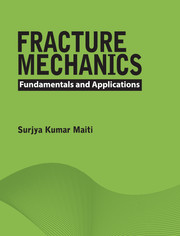Book contents
- Frontmatter
- Dedication
- Contents
- List of Figures
- List of Tables
- Preface
- 1 Introduction
- 2 Linear Elastic Fracture Mechanics
- 3 Determination of Crack-Tip Stress Field
- 4 Crack Opening Displacement, J Integral, and Resistance Curve
- 5 Determination of Stress Intensity Factors
- 6 Mixed Mode Brittle Fracture
- 7 Fatigue Crack Growth
- 8 Elastic Plastic Fracture Mechanics
- 9 Experimental Measurement of Fracture Tougness Data
- Index
- References
2 - Linear Elastic Fracture Mechanics
Published online by Cambridge University Press: 05 February 2016
- Frontmatter
- Dedication
- Contents
- List of Figures
- List of Tables
- Preface
- 1 Introduction
- 2 Linear Elastic Fracture Mechanics
- 3 Determination of Crack-Tip Stress Field
- 4 Crack Opening Displacement, J Integral, and Resistance Curve
- 5 Determination of Stress Intensity Factors
- 6 Mixed Mode Brittle Fracture
- 7 Fatigue Crack Growth
- 8 Elastic Plastic Fracture Mechanics
- 9 Experimental Measurement of Fracture Tougness Data
- Index
- References
Summary
Introduction
The foundation for the understanding of brittle fracture originating from a crack in a component was laid by Griffith (1921), who considered the phenomenon to occur within the framework of its global energy balance. He gives the condition for unstable crack extension in terms of a critical strain energy release rate (SERR) per unit crack extension. The next phase of development, which is due to Irwin (1957a and b), is based on the crack-tip local stress–strain field and its characterization in terms of stress intensity factor (SIF). The condition of fracture is given in terms of the SIF reaching a critical value, and the parameter is shown to be related to the critical energy release rate given by Griffith. Later, the scope of the SIF approach was amended to take care of small-scale plastic deformation ahead of the crack-tip. Most of the present applications of the principles of linear elastic fracture mechanics (LEFM) for design or safety analysis have been based on this SIF.
This chapter presents the gradual developments that have taken place to advance the understanding of fracture of brittle materials and other materials that give rise to small-scale plastic deformation before the onset of crack extension. Examples are presented to illustrate the applications of LEFM to design.
Calculation of Theoretical Strength
A fracture occurs at the atomic level when the bonds between atoms are broken across a fracture plane, giving rise to new surfaces. This can occur by breaking the bonds perpendicular to the fracture plane, a process called cleavage, or by shearing bonds along a fracture plane, a process called shear. The theoretical tensile strength of a material will therefore be associated with the cleavage phenomenon (Tetelman and McEvily 1967; Knott 1973).
Generally, atoms of a body at no load will be at a fixed distance apart, that is, the equilibrium spacing a0 (Fig. 2.1). When the external forces are applied to break the atomic bonds, the required force/stress (σ) increases with distance (a or x) till the theoretical strength σ c is reached. Further displacement of the atoms can occur under a decreasing applied stress. The variation can be represented approximately by a sinusoidal variation as follows.
- Type
- Chapter
- Information
- Fracture MechanicsFundamentals and Applications, pp. 6 - 64Publisher: Cambridge University PressPrint publication year: 2015
References
- 1
- Cited by



